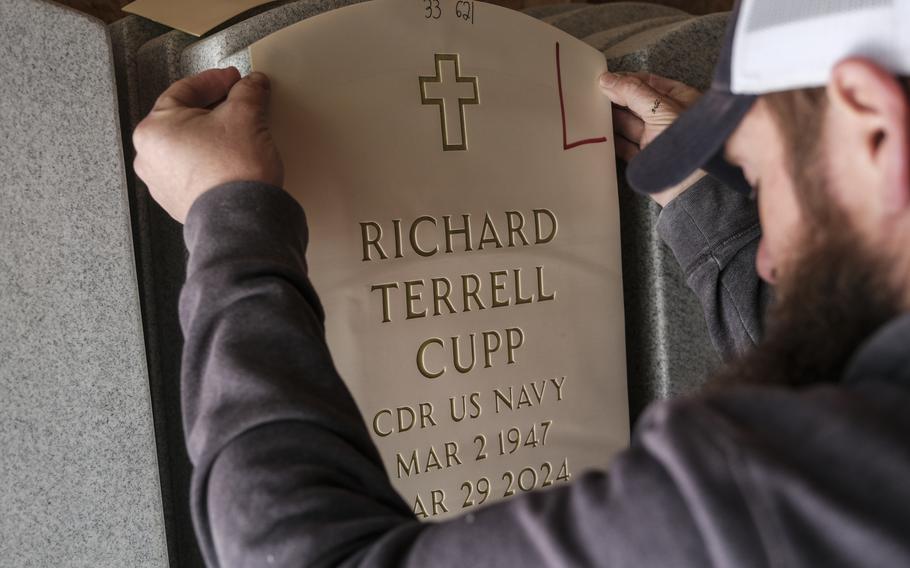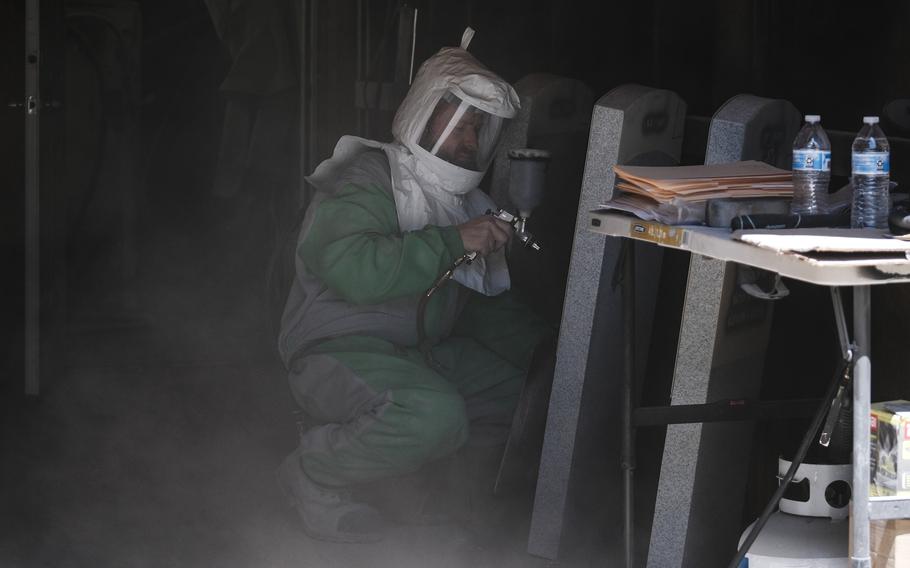
Adam Johnson prepares a headstone at the National Memorial Cemetery at Quantico in Triangle, Va. (Michael A. McCoy for The Washington Post)
Adam Johnson starts his morning driving through the National Memorial Cemetery at Quantico. He winds past thousands of gravestones, memorials to the men who fought on distant shores:
Europe.
Korea.
Vietnam.
Iraq.
Afghanistan.
There are graves of wives, too, and women who served in war. But mostly men.
The headstones are light gray in color, lined up in precisely spaced rows. Some list only the dates of birth and death and the deceased’s military rank. Others say “Beloved husband” and “Always in our hearts” and “Love you bud.”
Soon, Johnson arrives at a shed on the southern part of the 725-acre cemetery. He parks his car, lifts up the shed’s door and opens a UPS package. Inside are personalized stencils that Pinter Memorials has sent from its headquarters in Florida.
It’s hot outside. Weather experts predict record highs for the day.
Time to get to work.
Johnson started inscribing veterans’ gravestones almost by accident. In 2016, he was working a factory job in Wytheville, Va., making brake parts for tractor trailers. His brother-in-law worked for Vets USA, a company that inscribed gravestones, and told Johnson he could make more money in such a job but would have to move to Michigan. So, he did.
In 2021, he left Vets USA to work for Pinter Memorials, which assigned him to work at what was then Quantico National Cemetery, and now, after a name change, is the National Memorial Cemetery at Quantico. Johnson has been its dedicated inscriber for about three years. At a clip of about 30 a day and 120 a week, he’s finished thousands of gravestones for veterans and their family members.
His writing is what they and their descendants see when they visit their loved ones once or twice a year, perhaps more, perhaps less. It’s important that the writing looks crisp, clean. Nothing should distract from the ritual of mourning.
“This is the way I serve,” he says. “I do the best possible job that I can on every one of the stones because they deserve it.”
Wearing a protective nylon suit, he uses a blaster that shoots sand at 150 pounds per square inch to inscribe into granite and marble veterans’ names, ranks, service branches, wars they’ve served in, and their dates of birth and death.
He peels back the plastic on the back of the stencil and aligns it with the border of a gravestone for the gravestone’s border. When he’s satisfied, he presses his hand against the stencil and, in a wiping motion, pushes it against the granite. Then he grabs a metal roller and runs it over everything.
This headstone is for the wife of a private who served in World War II. She chose a Presbyterian cross, one of about 70 emblems available to top a gravestone.
“I get a lot of eagles, too, [and] doves,” he says as he rolls.
When he’s done, cemetery employees will haul the slabs across the grounds to install them at the veterans’ graves.

Johnson uses a blaster as part of the process. (Michael A. McCoy for The Washington Post)
The blast suit
At 2:52, Johnson emerges from the backroom for the last time and shuts off the air compressor. He’s done with inscribing for the day and quickly escapes the blast suit. At 3:13, he starts using a razor scraper to peel off the stencils and finishes them off by using a hunk of rubber to rub off any remaining stencil glue.
“One of my favorite things about granite is how sharp the turn out is, how nice the lettering and everything looks,” he says while scraping the stencil and glue off the headstone of a former Army private who served in World War II before becoming a “beloved husband, father, grandpa” and dying at the age of 97.
“There’s never any chipping away or anything like that,” Johnson adds. “It’s always just pristine.”
At 3:45, Johnson loads up a dolly with the first two stones, wheels them down a wooden ramp, wiggles them off and leans them against wooden pallets that have been placed on the side of a building. By 4:15, he’s brought all of them out.
It’s 4:48. Johnson scans the shed one last time, then trudges to the parking lot. On the way back through the cemetery, he passes the gravestones that he carved weeks, months and years ago.
He’ll be back in his shed tomorrow. Dozens of blank granite gravestones will be waiting for him to turn them into final send-offs for veterans he never met in life but feels compelled to honor in death.